

20th September 2025 (16 Topics)
Mains Issues
Context:
The Supreme Court temporarily stayed certain provisions of the Waqf (Amendment) Act, 2025, while upholding other key changes in the law.
Waqf (Amendment) Act, 2025:
Context & Background
Definition of Waqf:
- Permanent endowment of movable or immovable property by a Muslim for religious, charitable, or pious purposes.
- Managed by a Mutawalli to ensure income is used as intended (mosque upkeep, madrasa, charity).
- The Waqf (Amendment) Act, 2025 introduced comprehensive changes in Waqf property management, registration, and governance.
- Multiple petitions (~65) were filed challenging the Act’s constitutional validity, consolidated before the Supreme Court.
- Nearly 65 petitions from MPs and political parties challenging constitutional validity.
- Grounds: Violation of Article 26 (right to manage religious affairs), autonomy of Muslim community, and property rights.
Supreme Court Interim Order
- Nature of Interim Relief:
- No blanket stay; only select provisions temporarily stayed while the Act largely remains operational.
- Principle: Under Article 13(2), only provisions contravening fundamental rights are void; rest of the law can continue.
Key Provisions Stayed:
- Powers of District Collectors (Section 3C)
- DCs could declare Waqf property as government property during inquiry.
- Stay reason: Prima facie arbitrary; violates separation of powers.
- Interim safeguard: Waqf properties retain status; no dispossession or third-party rights until Tribunal adjudication.
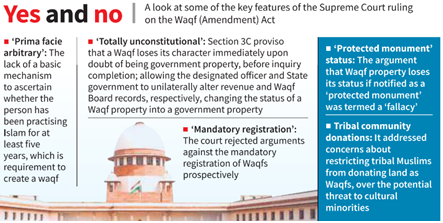
- Inclusion of Non-Muslims in Waqf Boards
- Original law allowed a non-Muslim majority in Waqf Boards/Central Waqf Council.
- SC capped representation:
- Central Waqf Council (22 members): max 4 non-Muslims.
- State Waqf Boards (11 members): max 3 non-Muslims.
- Rationale: Prevent infringement of community’s right to self-management.
- Five-year Rule for Practising Muslims
- Provision: Only Muslims practising Islam for ?5 years can create Waqf.
- Stay until the government frames rules to define “practising Muslim”.
Provisions Not Stayed
- Abolition of “Waqf by Use”
- Concept allowed properties used long-term for religious/charitable purposes to be Waqf without formal registration.
- Court found no prima facie ground to stay its prospective abolition.
- Applicability of Limitation Act
- Previously excluded under 1995 Waqf Act; now claims must follow general limitation periods.
- SC observed this corrects earlier discrimination; provision continues.
Significance of Interim Order
- Balances religious freedoms and government regulatory oversight.
- Prevents arbitrary dispossession while ensuring Waqf disputes are adjudicated by Waqf Tribunals.
- Provides clarity on non-Muslim participation limits in governance.
- Reinforces separation of powers and procedural safeguards.
Key Legal & Policy Analysis
- Constitutional Dimensions:
- Balancing Article 26 rights and government oversight.
- Ensures separation of powers by limiting arbitrary action by DCs.
- Protects minority rights while preventing misuse of Waqf provisions.
- Policy Implications:
- Formal registration improves accountability and prevents encroachments.
- Limitation Act application standardizes legal claims and prevents indefinite litigation.
- Inclusion of non-Muslims in Boards is limited to prevent erosion of community control, maintaining religious self-governance.


Mains Issues
Context:
The Index of Industrial Production (IIP) registered a 3.5% YoY growth in July 2025, with manufacturing expanding by 5.4%, supported by flagship policy initiatives, rising exports, and employment creation.
Manufacturing at a Turning Point
- Rising Industrial Output
- IIP grew 3.5% YoY in July 2025 compared to 1.5% in June.
- Manufacturing growth accelerated to 5.4% from 3.7% in the previous month.
- Policy-led Expansion
- PLI, National Manufacturing Mission, PM MITRA Parks, and Skill India are key drivers.
- The shift of global supply chains and domestic market expansion reinforce India’s strategic position.
Sectoral Engines of Growth
- Electronics
- Electronics production rose sixfold in the past decade; exports increased eightfold.
- India has become the world’s second-largest mobile manufacturer with ~300 units operating.
- Imports of mobile phones reduced from 75% (2014–15) to 0.02% (2024–25).
- Pharmaceuticals
- Contributes 50% of global vaccine demand and 40% of U.S. generics.
- Supported by PLI (?15,000 crore) and SPI (?500 crore).
- Industry projected to reach USD 130 billion by 2030.
- Automobiles
- Accounts for 7.1% of GDP and 49% of manufacturing GDP.
- Production of over 3.1 crore units in FY25, making India the 4th largest producer globally.
- Textiles
- Contributes 2.3% to GDP, 13% to industrial production, and 12% to exports.
- Expected to grow to USD 350 billion by 2030 and generate 3.5 crore jobs.
- PM MITRA Parks targeting ?70,000 crore investments and 20 lakh jobs.
Investment Flows & Global Confidence
- FDI Trends
- USD 748.78 billion FDI inflows in 2014–25, up 143% from 2003–14.
- FY25 gross inflows at USD 81.04 billion (+14% YoY).
- Manufacturing FDI rose to USD 19.04 billion (+18% YoY).
- Investor Geography
- Top states: Maharashtra (39%), Karnataka (13%), Delhi (12%).
- Top origins: Singapore (30%), Mauritius (17%), USA (11%).
Employment, Skills, and Human Capital
- Job Creation
- 17 crore jobs created in the last decade; manufacturing’s contribution to job creation rose to 15%.
- PLFS August 2025: UR eased to 5.1% overall, 5.0% for males.
- Skilling Initiatives
- Restructured Skill India Programme outlay: ?8,800 crore.
- Integrates PMKVY 4.0, NAPS, and Jan ShikshanSansthan to align skills with industry demand.
Policy Catalysts and Structural Reforms
- GST 2.0 Reforms
- Simplified two-slab structure, lower rates on essentials, reduced compliance burden.
- Beneficial for MSMEs, logistics, and auto sector.
- National Manufacturing Mission (NMM)
- Unified framework integrating ministries and states.
- Prioritises clean-tech manufacturing aligned with Net Zero 2070.
- PLI Scheme
- Outlay of ?1.97 lakh crore across 14 sectors.
- Boosted exports, scale, and competitiveness (smartphone exports crossed ?1 lakh crore in 5 months of FY26).
- National Logistics Policy
- Aims to reduce logistics cost and improve India’s LPI ranking.
- Startup India & Industrial Corridors
- Over 1.91 lakh recognized startups and 17.69 lakh direct jobs.
- Industrial corridors integrating manufacturing with urban development.
The Road Ahead: From Momentum to Leadership
- Deepen value addition in key sectors (electronics, pharma).
- Strengthen R&D and innovation ecosystems.
- Expand clean-tech and sustainable manufacturing.
- Improve MSME integration into global value chains.


Prelims Articles
Context:
The Supreme Court in SukdebSaha vs State of Andhra Pradesh (July 2025) recognized mental health as part of the right to life under Article 21.
Constitutional and Legal Significance
- Mental health recognized as integral to Article 21 (Right to Life).
- Builds upon Mental Healthcare Act 2017, elevating the statutory right to fundamental constitutional right.
- Establishes Saha Guidelines: mandatory mental health support in schools, colleges, hostels, coaching institutes; district-level monitoring committees; enforceable until Parliament enacts a full code.
Socio-Criminological Dimensions
- Highlights structural victimisation: systemic neglect by educational institutions and state contributes to student vulnerability.
- Connects to structural violence theory (Johan Galtung): indirect societal harm through denial of basic needs (mental well-being) is blameworthy.
- Shifts perspective: student suicides are public injustice, not only individual tragedy.
Policy and Implementation Challenges
- Judicial recognition alone insufficient; effectiveness depends on institutional compliance, resource allocation, and personnel training.
- Emphasizes the need for proactive measures: counselling, preventive mechanisms, and restorative interventions.


Prelims Articles
Context:
Supreme Court quashed Bombay High Court’s anticipatory bail order in Kiran vs Rajkumar Jivaraj Jain, reinforcing the bar on anticipatory bail under the SC/ST (Prevention of Atrocities) Act, 1989.
Supreme Court Reaffirms Legislative Intent
Background of the Case
- Incident:A Scheduled Caste member, alleged assault, caste abuse, sexual molestation of family members, looting, and threat with petrol in retaliation for not following voting directives.
- Procedural History:
- Sessions Court rejected anticipatory bail, citing casteist intent.
- Bombay High Court reversed, terming the case politically motivated and granted bail.
- Supreme Court intervened on appeal.
Legal Framework
- SC/ST (Prevention of Atrocities) Act, 1989:
- Section 18bars anticipatory bail for offences under the Act.
- Section 3(1)(r): Assaults or insults in public view counted as offences.
- Section 3(1)(o): Criminalizes coercion or retaliation for SC/ST voting choices.
- CrPC Reference: Section 438 (anticipatory bail) not applicable due to statutory bar.
- Constitutional Validation: Bar upheld under Article 14 (Equality) and Article 21 (Right to Life and Personal Liberty).
Supreme Court Observations
- High Courts cannot conduct “mini-trials” at bail stage; only prima facie case is examined.
- Offences outside complainant’s home, in public view, fulfill statutory requirement.
- Electoral retaliation against SC/ST voters carries broader democratic implications.
- Evidence such as witness accounts, medical reports, and recovery of weapons strengthened prosecution.
Analysis and Way Forward
- Legal Significance:
- Reinforces protective intent of SC/ST Act; prevents intimidation of marginalised communities.
- Courts must strictly apply prima facie test without slipping into evidentiary evaluation.
- Social and Democratic Implications:
- Upholds the dignity and safety of SC/ST communities.
- Protects electoral rights of marginalized voters, discouraging caste-based coercion.


Prelims Articles
Context:
UNICEF reports that for the first time, global obesity among school-aged children and adolescents exceeds underweight, affecting 1 in 10 children.
Global Malnutrition Trends
- Prevalence of underweight among children aged 5–19 declined from 13% in 2000 to 2% in 2025.
- Obesity rates increased from 3% in 2000 to 4% in 2025, surpassing underweight globally except in Sub-Saharan Africa and South Asia.
- Approximately 188 million children and adolescents live with obesity.
Regional and Country-Specific Data
- Pacific Islands: Highest prevalence – Niue (38%), Cook Islands (37%), Nauru (33%) due to shift to energy-dense imported foods.
- High-income countries: Chile (27%), USA (21%), UAE (21%).
- Highlights the double burden of malnutrition, where undernutrition and obesity coexist.
Health Implications
- Obesity in children increases risk of insulin resistance, hypertension, type-2 diabetes, cardiovascular diseases, and certain cancers.
- Overweight children: above healthy weight for age, sex, height; obesity is severe form of overweight.
Role of Ultra-Processed Foods and Marketing
- Ultra-processed foods (high sugar, salt, unhealthy fats) dominate shops and schools.
- Digital marketing targets children: 75% of youth recalled ads for sugary/fast foods; 60% influenced to consume.
- Even conflict-affected regions report high exposure to unhealthy food marketing.
Economic and Policy Implications
- Obesity-related economic costs projected to exceed US$4 trillion globally by 2035.
- Governments taking action:g., Mexico banned ultra-processed foods in public schools, positively impacting over 34 million children.
- UNICEF recommendations:
- Mandatory food policies: labelling, marketing restrictions, taxes/subsidies.
- Behavioral change interventions for families and communities.
- Ban ultra-processed foods in schools and protect policy-making from industry interference.
- Strengthen social protection for vulnerable families.


Prelims Articles
Context:
India’s trade deficit contracted sharply to $9.9 billion in August 2025 due to higher exports and reduced imports.
Trade Deficit Contraction
- India’s trade deficit in August 2025 fell to $9.9 billion, down 54% from $21.7 billion in August 2024.
- The reduction was driven by higher merchandise and services exports and a decline in merchandise imports.
Exports Performance
- Total exports: $69.2 billion, up 9.3% from last year.
- Merchandise exports: $35.1 billion, growth of 6.7% over August 2024.
- Services exports: $34.1 billion, up from $30.4 billion last year.
- Notable export partner:S. exports rose to $6.86 billion, despite 25-50% tariffs imposed on Indian goods.
Imports Performance
- Total imports: $79 billion, down 7% from $85 billion last year.
- Merchandise imports: $61.6 billion, contraction of 10.1%.
- Services imports: increased marginally to $17.45 billion.
- Reduced import demand, particularly for merchandise, helped narrow the deficit.
Cumulative Trade Balance
- April–August 2025 trade deficit: $41.4 billion, 20.1% lower than April–August 2024.
- Indicates resilient export performance and partial import moderation, contributing to macroeconomic stability.
Policy Implications
- Reflects effective government trade policies, export incentives, and resilience of India’s services sector.
- Shows global competitiveness despite trade uncertainties and tariffs.


Prelims Articles
Context:
NITI Aayog report highlights how Artificial Intelligence (AI) adoption across industries can boost India’s GDP growth toward 8% in the coming years.
Economic Impact of AI:
- AI can bridge 30–35% of the gap between India’s current GDP growth rate and the 8% target.
- Industries like pharmaceuticals, manufacturing, automobiles, and financial services are key candidates for AI-driven efficiency gains.
Pharmaceutical Sector Example:
- AI reduces cost of producing new molecules by ~10 times and cuts development time (~10 years) by ~50%.
- Enhances India’s potential for global drug innovation.
Workforce and Skilling Implications:
- AI adoption may disrupt jobs; measures suggested include mapping job shifts, lifelong learning, MSME digital upskilling, and protection for gig/platform workers.
Strategic Implications:
- India aims to take a leadership role in global AI impact, leveraging technology for both economic and international strategic advantages.

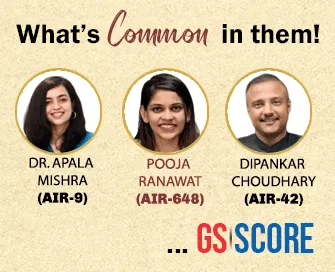
Prelims Articles
Context:
India has overtaken China as the top smartphone exporter to the United States in Q2 2025, while smartphone exports from India crossed ?1 lakh crore in the first five months of FY 2025-26.
Mobile Manufacturing Boom
- India is now the second-largest mobile phone manufacturer globally, with over 300 manufacturing units, up from just 2 in 2014.
- Exports Growth: Mobile phone exports rose from ?1,500 crore in FY 2014-15 to over ?2 lakh crore in FY 2024-25, making smartphones the fourth-largest export item from India.
Government Schemes Driving Growth:
- Production Linked Incentive (PLI) Scheme (2020) has incentivised large-scale electronics manufacturing.
- Make in India (2014), Digital India (2015), SPECS, NPE 2019, and ECMS 2025 have collectively strengthened the ecosystem.
Economic Contribution:
- Electronics production rose from ?1.9 lakh crore in 2014-15 to ?11.3 lakh crore in 2024-25. Mobile phones alone reached ?5.45 lakh crore in production.
Strategic Context:
- The China+1 strategy has shifted global supply chains towards India, making it a resilient alternative in electronics manufacturing.
Digital Economy Link:
- By 2029-30, India’s digital economy is projected to contribute nearly 20% of GDP, surpassing agriculture and manufacturing.


Prelims Articles
Context:
As of September 2025, the PM Vishwakarma Scheme has registered around 30 lakh artisans, with more than 26 lakh completing skill verification and 4.7 lakh loans sanctioned worth ?41,188 crore.
Background and Launch:
- Launched on 17 September 2023 (Vishwakarma Jayanti).
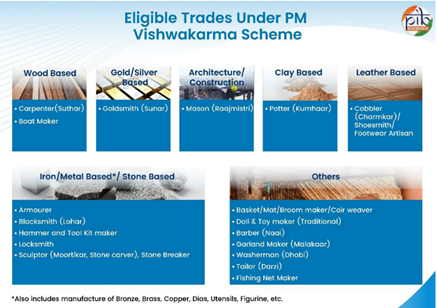
- Financial outlay:?13,000 crore (FY 2023-24 to 2027-28).
- Jointly implemented by MoMSME, MSDE, and DFS (MoF).
Coverage and Trades:
- Targets artisans in 18 family-based traditional trades (e.g., carpenter, blacksmith, mason, potter, tailor, cobbler, barber, washerman, mat maker, etc.).
- Special focus on women, SCs, STs, OBCs, PwDs, transgenders, NER states, hilly and island territories.
- Raajmistri (Mason) is the most registered trade.
Key Benefits:
- Recognition: PM Vishwakarma Certificate and ID Card.
- Skill Upgradation: Basic/advanced training; ?500 daily stipend.
- Toolkit Incentive: ?15,000 e-voucher for modern tools.
- Credit Support: Two collateral-free tranches – ?1 lakh (18 months), ?2 lakh (30 months); concessional interest 5% (with 8% GoI subvention).
- Digital Incentive: ?1 per digital transaction (max 100/month).
- Market Linkages: Branding, fairs, exhibitions, certification, GeM onboarding, Udyam Assist Platform.
Impact Till 2025:
- 30 lakh artisans registered; 86% completed training.
- 23 lakh toolkit e-vouchers issued.
- 7 lakh loans sanctioned (?41,188 crore).
- Active presence across 618 districts with 497 DPMUs.


Prelims Articles
Context:
A global study shows artificial light at night is extending activity hours of birds, disrupting natural rhythms and ecosystems.
Impact on Bird Behavior:
- Birds in brightly lit areas remain active nearly an hour longer than in darker areas.
- Large-eyed species and open-nesters are most affected, while small-eyed and cavity-nesting species are less impacted.
- Migratory birds and breeding-season activity show the most pronounced changes.
Ecological Consequences:
- Altered activity affects feeding, reproduction, and migration.
- Disruption of circadian rhythms may cascade through food chains, impacting plant-pollinator interactions and insect populations.
- Fireflies and other nocturnal species also face survival challenges due to artificial lighting.
Technological and Citizen Science Role:
- Use of AI-powered platforms like BirdNETand volunteer acoustic networks (BirdWeather) enables large-scale monitoring of bird vocalisations globally.
- Data reveals species-specific responses to light pollution, supporting targeted conservation strategies.
Mitigation Potential:
- Unlike habitat loss, light pollution is reversible: streetlights can be shielded, billboards dimmed, and lights switched off when unnecessary.
- Behavioural interventions can reduce light pollution effectively without large financial investments.


Prelims Articles
Context:
Madhya Pradesh plans to establish a second indigenous population of cheetahs at Gandhi Sagar Wildlife Sanctuary to expand conservation efforts.
Background & Significance:
- Kuno National Park currently hosts 29 cheetahs, reintroduced from southern Africa (2022–2023).
- Cheetahs were extinct in India in the wild before 20 individuals were relocated from Africa.
- Gandhi Sagar Sanctuary in Madhya Pradesh is selected for the second population to increase species survival and genetic diversity.
Reproduction &Behaviour:
- Female cheetahs reach sexual maturity at 25–30 months; males mature later.
- Gestation lasts ~3 months; litters can include up to six cubs.
- Female cheetahs care for cubs intensively, feeding them 1.5 kg of food daily.
- Mating involves estrus cycles, territorial interactions, and post-birth protective behaviour.
Threats & Conservation Measures:
- Threats include predation (leopards, co-predators) and extreme weather (heat).
- Monitoring involves dedicated personnel, cameras, and veterinary oversight for health and cub survival.
- Conservation emphasizes habitat protection, genetic diversity, and reducing human-wildlife conflicts.
Strategic Implications:
- Expands India’s wildlife conservation footprint.
- Supports IUCN-recommended species recovery programs.
- Enhances potential eco-tourism and local biodiversity awareness.


Prelims Articles
Context:
India has secured its first-ever licence from the International Seabed Authority (ISA) to explore polymetallic sulphide nodules in the Carlsberg Ridge of the northwest Indian Ocean.
About Polymetallic Nodules
- Nodules are rock concretions on the seabed rich in manganese, cobalt, nickel, and copper.
- These metals are critical for high-tech industries, renewable energy technologies, and strategic applications.
- Exploration of these nodules is part of the blue economy and marine mineral resources
Geographical Significance
- Carlsberg Ridge: ~3,00,000 sq.km, located in the Arabian Sea and northwest Indian Ocean.
- Forms the boundary between Indian and Arabian tectonic plates, extending from Rodrigues Island to the Owen Fracture Zone.
- Other areas of interest include the Afanasy-Nikitin Sea (ANS) mount in the Central Indian Ocean.
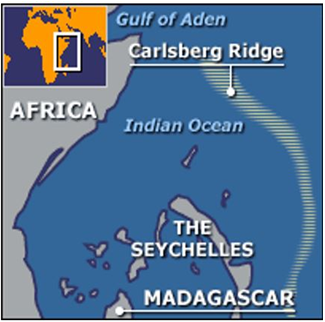
Legal and Strategic Framework
- Deep-sea areas beyond national jurisdiction (high seas) are regulated by the International Seabed Authority (ISA) under UNCLOS.
- Countries can claim up to 350 nautical miles (continental shelf), and in some Bay of Bengal cases, up to 500 nautical miles.
- India has previously obtained ISA exploratory rights:
- Central Indian Ocean Basin (2002–2027)
- Polymetallic sulphides in Indian Ocean Ridge (2016–2031)
Strategic Implications for India
- Strengthens India’s position in the global marine mineral resources arena.
- Supports technological advancement and strategic mineral security.
- Enhances India’s role in international governance of oceans and blue economy initiatives.

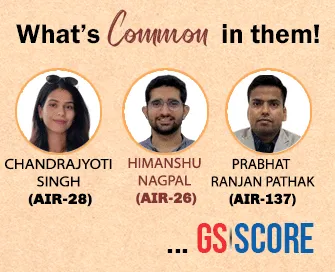
Prelims Articles
Context:
The 8th RashtriyaPoshanMaah was launched on September 17, 2025, by the Prime Minister along with the SwasthNariSashaktParivar Abhiyan, highlighting nutrition as a cornerstone of national development.
Background of PoshanAbhiyaan:
- Launched in March 2018 at Jhunjhunu, Rajasthan, as Prime Minister’s Overarching Scheme for Holistic Nourishment (POSHAN).
- Targets children under 6 years, adolescent girls, pregnant women, and lactating mothers.
- Focuses on first 1,000 days, convergence of schemes (ICDS, NHM, Swachh Bharat), and community mobilisation under Jan Andolan.
Current Status and Key Achievements:
- As of September 2025, 14,02,248 Anganwadi Centres and 14 crore beneficiaries registered on the Poshan Tracker app (launched March 2021).
- NFHS-5 (2019–21): Stunting reduced (38.4% ? 35.5%), underweight prevalence declined (35.8% ? 32.1%), wasting decreased (21% ? 19.3%).
- 4 crore children/adolescents received Iron and Folic Acid supplements in Q2 FY 2024-25.
Associated Schemes and Initiatives:
- PM POSHAN Scheme (2021–26): Outlay ?1,30,794.90 crore; covers 11.80 crore children across 11.20 lakh schools.
- Provides hot cooked meals (100g/day for primary, 150g/day for upper primary) under NFSA, 2013.
- Includes Balvatika (pre-primary), summer meals in disaster-hit areas, and 9.5% material cost hike (2025) indexed to CPI-RL.
- Other initiatives: PoshanMaah, PoshanPakhwada, PoshanVatika, and Children Nutrition Park (Ekta Nagar, Gujarat).
Themes of 8th PoshanMaah (2025):
- Reducing obesity through lower sugar and oil consumption.
- PoshanBhiPadhaiBhi (ECCE integration with NEP 2020).
- Ek Ped MaaKe Naam (nutrition-environment linkage).
- Infant & Young Child Feeding (IYCF) practices.
- Men’s involvement in caregiving and nutrition.


Editorials
Context:
Uttar Pradesh launched India’s first Women’s Economic Empowerment (WEE) Index to track women’s participation across multiple economic levers.
Present Status and Gaps
- Low GDP Contribution: Women contribute only 18% to India’s GDP, despite constituting half the population.
- Workforce Exclusion: Nearly 196 million employable women remain outside the labour force.
- Formal Employment Gap: Of the 41.7% women in the workforce, only 18% are in formal jobs, showing structural exclusion.
Role of WEE Index
- Comprehensive Tracking: Index measures women’s status across employment, education & skilling, entrepreneurship, livelihood, mobility, and safety.
- Catalytic Impact: Gender-disaggregated data has already prompted reforms in Uttar Pradesh’s transport sector such as women’s recruitment and infrastructure facilities.
- Systematic Insights: Helps map drop-off points from school to skilling, and skilling to entrepreneurship, exposing barriers to credit and enterprise support.
Future Imperatives
- Data Mainstreaming: Gender-disaggregated data must be integrated into all departmental management systems at district and state levels.
- Beyond Gender Budgeting: True gender budgeting should apply a gender lens to every rupee spent, not just welfare schemes.
- Scaling Framework: Other states with trillion-dollar economic goals must replicate WEE Index to harness the gender dividend.
Practice Question
“Gender-disaggregated data is the foundation for inclusive growth. Discuss how tools like the Women’s Economic Empowerment (WEE) Index can address India’s gender gap and contribute to achieving its $30 trillion economy vision by 2047.” (250 words)


Editorials
Context:
The Supreme Court issued an interim order on the Waqf (Amendment) Act, 2025, staying select provisions while rejecting pleas for relief on others.
Supreme Court Interim Ruling
- Partial Stay: The Court temporarily stayed Section 3(r) of the Act, which defines “practising Muslim” and gives authorities power to regulate religiosity.
- Challenge of Constitutionality: Most other provisions were upheld, as parliamentary provisions are generally the “rarest of rare” cases, not easily struck down.
- Limited Relief: Petitioners’ plea to exempt small Waqf boards or private management was rejected, maintaining state oversight.
Legal and Religious Implications
- Property Rights: The Act does not alter ownership; individuals can still create or donate Waqf, but trustees have control.
- Minority Concerns: Court’s ruling clarified that non-Muslims’ rights remain unaffected, but concerns remain about administrative overreach.
- Religious Autonomy: The interpretation of “practising Muslim” introduces morality-based policing, raising questions on secularism and religious freedom.
Wider Governance and Policy Effects
- State Oversight: Government maintains authority through registration and monitoring of Waqf properties.
- Judicial Precedents: Cites earlier rulings such as PedaVenkatanarayan&Arur Singh, emphasizing trustee rights and limits on state interference.
- Future Implications: The order signals careful balancing between reform, minority protection, and administrative efficiency, leaving full legal questions unresolved.
Practice Question
“Critically analyse the Supreme Court’s interim order on the Waqf (Amendment) Act, 2025, in the context of religious freedom, minority rights, and state regulation of charitable trusts in India.” (250 words)


Editorials
Context:
The Government of India recently amended General Financial Rules (GFR) 2025, introducing exemptions from the Government e-Marketplace (GeM) and enhanced financial thresholds to improve R&D procurement.
Understanding the Reform
- Policy Shift: The reforms allow institutional heads to bypass GeM for specialised R&D equipment and raise direct purchase limits from ?1 lakh to ?2 lakh.
- Delegated Authority: Approval powers for global tenders up to ?200 crore are delegated to vice-chancellors and directors, reducing bureaucratic delays.
- Catalytic Procurement: The changes align with the principle of using procurement as a driver of innovation rather than mere cost control.
Global Best Practices
- Germany’s Approach: Through its High-Tech Strategy and KOINNO agency, procurement is linked with innovation promotion and supplier ecosystem building.
- United States Model: The SBIR programme reserves federal R&D funds for startups, fostering early-stage innovation through phased procurement contracts.
- South Korea’s Example: Pre-commercial procurement supports prototypes and moonshot technologies, prioritising ambition over cost benchmarks.
Challenges and Way Forward
- Implementation Risk: Success depends on monitoring misuse while maintaining agility and building institutional trust in procurement discretion.
- Domestic Ecosystem: Over-reliance on global tenders may marginalise Indian suppliers unless domestic R&D is empowered to compete globally.
- Future Path: Suggested reforms include outcome-weighted tenders, AI-augmented sourcing, sandbox exemptions, and co-procurement alliances among Indian labs.
Practice Question:
“Public procurement reforms can act as a catalyst for India’s research and development ecosystem. Critically analyse with reference to the General Financial Rules (GFR) 2025 reforms.” (250 words)



